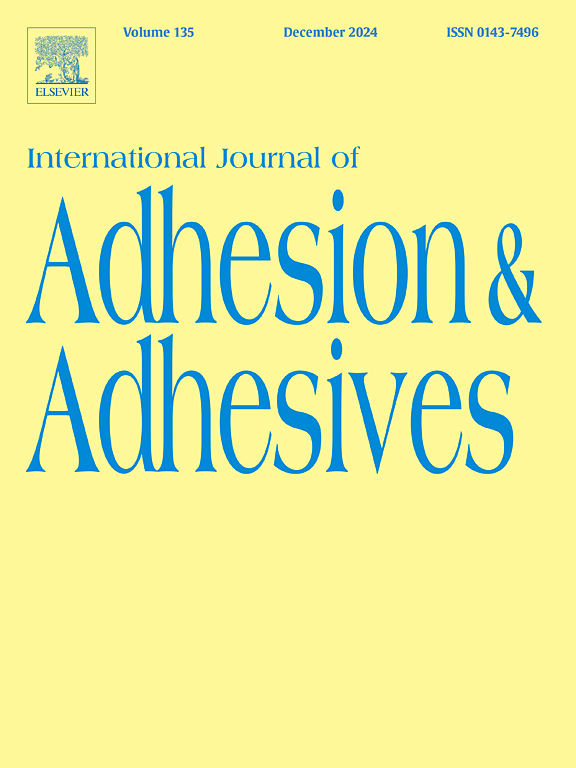Enhancing the antibacterial effect of dental adhesives with DMAHDM by incorporating MPC monomer: A systematic review and meta-analysis of in vitro studies
IF 3.2
3区 材料科学
Q2 ENGINEERING, CHEMICAL
International Journal of Adhesion and Adhesives
Pub Date : 2024-10-09
DOI:10.1016/j.ijadhadh.2024.103849
引用次数: 0
Abstract
Objective
This systematic review aims to analyze if the combination of MPC and DMAHDM can enhance the antibacterial potential of DMAHDM without impairing the adhesive system's bond strength.
Methods
A search was conducted on PubMed, Embase, Scopus, and Web of Science databases. Study selection was performed in two stages by two calibrated reviewers independently. The meta-analyses were conducted with the RevMan 5.4 software and evaluated metabolic activity (MA), lactic acid production (LA), protein repellent function (PRF), and dentin shear bond strength (DSBS) comparing DMAHDM vs. DMAHDM + MPC. The measure of effect was the mean or standardized mean difference. Quality assessment was evaluated with an adapted tool from a previous systematic review.
Results
The initial search resulted in 158 articles. Four articles were included in the final sample. The meta-analyses evidenced a statistically significant difference favoring the use of MPC to enhance DMAHDM's antibacterial potential for inhibiting MA (SMD, 3.74; 95 % CI, 2.66, 4.83), LA (MD, −1.24; 95 % CI, −1.42, −1.06), while providing protein-repellent function (MD, −5.38; 95 % CI, −6.35, −4.41). The addition of MPC had a negative effect on DSBS in comparison to DMAHDM alone (MD, −4.23; 95 % CI, −5.63, −2.83).
Conclusions
The addition of MPC to DMAHDM-containing adhesives enhances the antibacterial efficacy and provides protein-repellent function, but impairs the bond strength. Future studies should test the addition of 5 % MPC.
通过加入 MPC 单体增强 DMAHDM 牙科粘合剂的抗菌效果:体外研究的系统回顾和荟萃分析
方法 在 PubMed、Embase、Scopus 和 Web of Science 数据库中进行检索。研究筛选分两个阶段进行,由两名经过校准的审稿人独立完成。荟萃分析使用 RevMan 5.4 软件进行,对 DMAHDM 与 DMAHDM + MPC 的代谢活性 (MA)、乳酸生成 (LA)、蛋白质排斥功能 (PRF) 和牙本质剪切粘接强度 (DSBS) 进行了评估。衡量效果的标准是平均值或标准化平均值差异。质量评估采用了从以前的系统综述中改编的工具。最终样本包括 4 篇文章。荟萃分析表明,使用 MPC 可增强 DMAHDM 在抑制 MA(SMD,3.74;95 % CI,2.66,4.83)、LA(MD,-1.24;95 % CI,-1.42,-1.06)方面的抗菌潜力,同时提供驱蛋白功能(MD,-5.38;95 % CI,-6.35,-4.41),两者之间的差异具有统计学意义。与单独使用 DMAHDM 相比,添加 MPC 对 DSBS 有负面影响(MD,-4.23;95 % CI,-5.63,-2.83)。今后的研究应测试添加 5% MPC 的情况。
本文章由计算机程序翻译,如有差异,请以英文原文为准。
求助全文
约1分钟内获得全文
求助全文
来源期刊

International Journal of Adhesion and Adhesives
工程技术-材料科学:综合
CiteScore
6.90
自引率
8.80%
发文量
200
审稿时长
8.3 months
期刊介绍:
The International Journal of Adhesion and Adhesives draws together the many aspects of the science and technology of adhesive materials, from fundamental research and development work to industrial applications. Subject areas covered include: interfacial interactions, surface chemistry, methods of testing, accumulation of test data on physical and mechanical properties, environmental effects, new adhesive materials, sealants, design of bonded joints, and manufacturing technology.
 求助内容:
求助内容: 应助结果提醒方式:
应助结果提醒方式:


